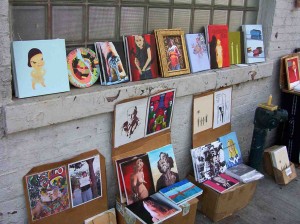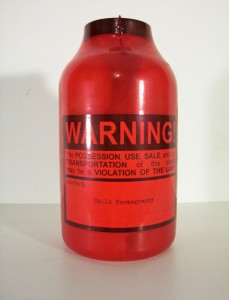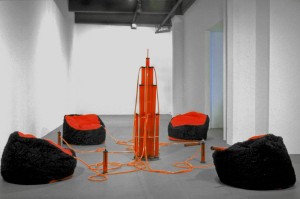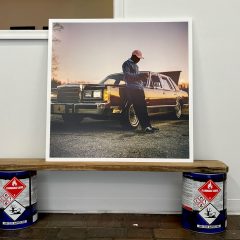Eric Doeringer is best known for a series of forgeries that he sells on the streets of New York City and yes, in galleries. He calls this series “Bootlegs” because the works are copies of contemporary paintings made famous by all the usual suspects within the art star system. These aesthetic clones have become a type of barometer for contemporary art’s appeal to the random person on the street. Eric can tell you what the public really likes in terms of well-known works of art made in the past fifteen years. The original vs. the copy is often misunderstood and the “Bootleg” series is no exception, Eric’s appropriations force the viewer to reconsider idealized concepts about creativity and the value we place on the new. Doeringer, who is represented by Creative Thriftshop , curated the upcoming group exhibition “I Like The Art World And The Art World Likes Me” at efa Project Space. That show opens January 14th. I met the artist last month in New York to ask him about his work.

Corey Armpriester – How many lawyers do you and your gallery have on retainer?
Eric Doeringer – I don’t have any lawyers on retainer, I don’t know about the gallery. I have used Volunteer Lawyers For the Arts and have consulted with them on a few things. So far, I haven’t had any serious legal trouble.
CA – How often are you arrested by NYPD for selling art on the streets of NYC?
ED – I was never actually arrested, I did have an issue once with an art dealer who called the police on me because he didn’t like the idea that I was out on the street selling art. (Click here for more on that story.)
CA – Was that Mike Wiess?
ED -Yes.
CA – I tried getting him on the phone but he never returned my call.
ED – He probably doesn’t want to talk about it. At the time my understanding was that you could sell art on the streets of New York City. It turns out that it’s true and it is a part of your first amendment rights. But if you’re selling something you have to get a certificate of authority, which basically means registering to pay sales tax to the state. The cops asked if I had that and I didn’t, so they made me pack up for the day but didn’t actually arrest me.
CA – Did you confront Mike Wiess?
ED – I did. The story is he came by the week before and said “I don’t like you being out here so don’t come back” and my response was “Hey, fuck you. I have a right to be here.” I had actually been selling art on the street longer than he had his gallery.
CA – How many paintings do you have in the “Bootleg” series?
ED – Well, I think I’ve copied work from over 100 different artists. When I make them I make them assembly line style in a batch of six or ten at a time.
CA – Your biggest seller?
ED – Richard Prince tends to do very well; Warhol and Damien Hirst are consistent big sellers.
CA – Why has the art world made your “Bootlegs” official (i.e., shown and sold inside galleries and collected by insiders)?
ED – Personally I think they’re great pieces.
CA -Why are you so passionate about appropriation?
ED – I guess I’m interested in the relationship between the copy vs. the original. Over a period of time I continue to explore this idea of the copy. I’ve currently been doings things that are based on late sixties conceptual art about the dematerialization of the object and losing the hand of the artist in the process and what does it mean to recreate these pieces and is my hand evident. How is a Warhol I’ve done different from the one authorized from his estate?
CA -Did art school ultimately help or hurt your creative expression?
ED – I think it definitely helped it.
CA – How?
ED – Well, I would say when I was in school I learned a lot of things and the practice of critique was enormously helpful, having this space to do things and getting feedback was all very helpful.

CA -You had a blog titled “The Shit Stream” (2007-2009) where you would post a daily photograph of your bowel movements. What lessons have you learned from this art project?
ED – I was interested in the limits of what is acceptable as art and what is considered obscene. Shit is something a lot of people consider obscene or they can’t look at but at the same time it’s something that comes out of all our bodies and we all do it everyday and in some way, it’s a self portrait, a little sculpture.
CA – What does your mother think about the Shit Stream work?
ED – I don’t know if my mother ever really told me how she felt about it.
CA -How have your circle of friends (artists) reacted to the rise of your celebrity?
ED – Well, I don’t think I’m really that famous.
CA – Humble people give horrible interviews.
ED -(laughs) A lot of my friends are successful artists. I think they’re happy for me.
CA – Are you one of many dangerous elements in the art world today?
ED – (laughs) I don’t think there are many dangerous elements in the art world. I think in many ways the art world is a pretty safe place to be subversive.
CA – Are you encouraged by art stars to copy their work?
ED – Funny you ask; the people that ask are not the people I would copy.
CA – Who asked?
ED – Generally the people that ask me to make a copy are not famous enough. That work (Bootlegs) is about the art market.
CA -Which paintings from the “Bootleg” series are the worst sellers?
ED – If there was an artist that didn’t sell very well I would phase them out.
CA -Who didn’t sell so well?
ED – I don’t know if I should say that.
CA – Why is this an issue?
ED – I never know why a painting doesn’t sell. Maybe that artist wasn’t that popular or my version wasn’t that good.

CA – In your series “Contraband” (collection of sculptures) you have child pornography encased in a plastic bottle. Is this an example of “WHEN ART ATTACKS?”
ED – With the “Contraband” project there are bottles that hold different things and some of them are illegal across the country; some of them are illegal in certain states but legal in other states; some of them are illegal to possess but not to import or export. You can’t see what’s in the bottle unless you destroy the sculpture.
CA – Where did you get the child pornography?
ED – I got it from a friend that collected unusual pornography.
CA – Why haven’t you been arrested?
ED – Probably because it has not been exhibited in a high profile exhibition. When I have exhibited them, I have been a little bit afraid about arrest; my hope is that people will see it as an artistic gesture and not as some sort of threat to society.
CA – Do you have a patron?
ED – Do I have a patron? You mean someone that pays my rent every month, commissions work, or buys my work?
CA – All of the above.
ED – I don’t have anyone that pays the rent every month. I have people that have bought a lot of work from me and commission specific pieces from me.
CA -Do you wait for inspiration?
ED – Sometimes.

CA – Have you used your “Smoke Filtration Systems” (bong-like sculptures) to smoke anything?
ED – I never smoked anything out of them. I did test them to make sure they worked. That work was exploring the idea of when is it art and when is it illegal.
CA -Tell me about your 2011 curatorial project “I like the art world and the art world likes me.”
ED – That’s the show I’m curating to open next month at the efa Project Space in New York City. It’s an exhibition of artists that make art about the art world.
CA – What are your perceptions of the art world?
ED – My perception of the art world changed a lot the more involved I become. When I got out of grad school and I moved to New York I had this idea that once you got a gallery you were totally taken care of — they sell your work, show your slides to museums, promote your shows. I think I sort of had this view of the dealer as being this wonderful person that’s going to make your career and that’s certainly the image they try to project. But as I’ve become more of an insider you realize that the dealer is starving just as much as the artist and lot of them have day jobs also.
CA – Dealers with a day job?
ED – Dealers with a day job is not uncommon, or they have a wealthy backer.
CA – So, what does you’re dealer do for you?
ED – That’s a good question.
CA – Do you think appropriation is an anti-creative act?
ED – No, I don’t think so at all. In the art world appropriation is now a very accepted manner of working. In our legal system, there really is no acceptance of appropriation as a creative act.
CA – Do you think your work (Bootlegs) is original?
ED – I think my work is very original.
CA -Are you misunderstood?
ED – Yeah, by a lot of people but there are a lot of people that get it and who are on my side. Some people think we recycle the past and some think we’re not moving forward.









